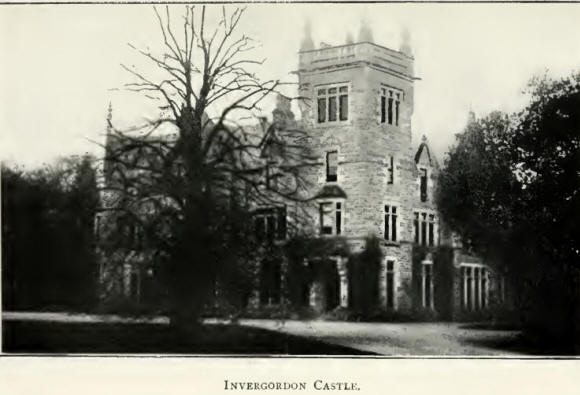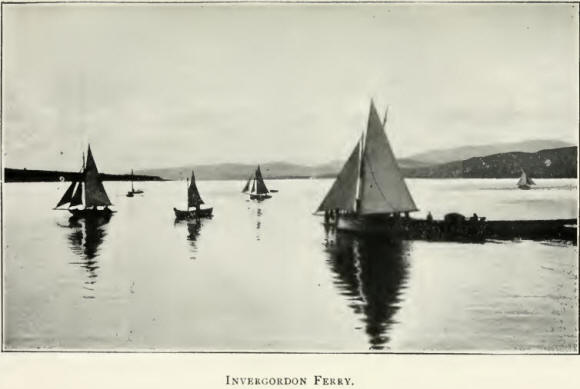|

The Burgh of Invergordon
stands, as has already been pointed out, on a promontory which gives it not
only a commanding scenic situation but has helped it in the formation of a
commodious harbour which has done much for the district. The town itself
consists principally of one long broad street with many side streets built
at right angles. At present it is plain that any description of the town as
it is, must in the course of a year or two be completely out of date, as
there is much activity in the erection of all kinds of buildings. There is
now in course of erection more large oil tanks for the navy, new hotels,
club houses, and dwellings of all kinds to meet the requirements of those
who have business in connection with the navy.
It is only this year (1914) that Invergordon celebrates its jubilee as a
burgh, though it has for much more than fifty years been a busy seaport town
in regular communication with such places as Cromarty, Inverness! Aberdeen,
London, etc.
Only two or three years ago the inhabitants were debating as to how ‘ its
trade and commerce could be improved, and plans for making it a desirable
seaside summer resort were thought of, but the making of the Cromarty Firth
a naval base has altogether altered the outlook. The inhabitants were never
of the type that looked simply to the past, rather have they been looking to
the future, and now, that a future is assured them they have acquired quite
an American atmosphere of keenness and hustle, and much business is daily
being done at the commodious and well equipped shops here.
The town possesses since 1870 a hanasome town hall, Italian in architecture.
The pediment shows a sculptured figure of Neptune with his proper attributes
of cornucopia, bulrushes, water urn, etc. It has seating accommodation for
five hundred people. A noticeable building is the United Free Church which
is Gothic in style and cruciform in plan, with a spire 160 feet high. The
Established Church of the parish is situated more than a mile to the west of
the town. There is a handsome well-built and excellently equipped academy
here with accommodation for about four hundred pupils, many of whom travel
to it long distances daily by rail, etc., because of the excellence of
education got here. There are as yet branches of only two banks here—the
Commercial and the North of Scotland, both of which have handsome buildings
in the main street.
In 1902 King Edward and Queen Alexandra landed here, and had a right royal
welcome. To commemorate that visit a handsome lamp and fountain were erected
in the most central part of the town.

The town can also boast of
being the first to publish a newspaper in the county, “The Invergordon
Times,” which has been regularly issued since 1855.
Here the Freemasons have a lodge as have also the Oddfellows and Good
Templars. There are Literary, Dramatic and Debating Societies, tennis,
bowling, cricket, golf and football clubs. There are Dorcas and Temperance
Societies, and, most popular of all, a Regatta and Boating club, indeed the
Invergordon Annual Regatta is one of the most popular events in the whole
district and year by year so excellent is the programme submitted that to
witness the events, large and fashionable crowds gather into the town during
the two days over which the Regatta extends.
THE FOUNDER OF INVERGORDON.
Sir William Gordon, the first baronet of Invergordon, he who gave the town
its present name, which really is quite a modern one, was in his time one of
the best known public men in Scotland. This Sir William succeeded his father
Sir Adam in 1700 and was one of the few people who made money of the South
Sea Bubble. He ultimately became a rich banker in London. Where he got his
original wealth is a mystery, but rich he was, and honours fell to him in
rapid succession. He was created a baronet in 1704, was made a burgess of
Edinburgh in 1708 (his ticket is preserved among the Laing charters in
Edinburgh University), he represented Sutherlandshire in five Parliaments
(1708-1727) and Cromartyshire from 1741-1742. He was commissioner for
stating debts due to the army and he had the satisfaction of having two
grandsons ennobled (Lord Melville and Lord Cromarty). He had much influence
with the Earl of Sutherland and had a residence at Uppat near Dunrobin. He
bought the estate of Inverbreakie from the Macleod family (who had borrowed
the money from his father) and re-christened it Invergordon. But he had his
difficulties with the customs and with a Ludovick Gordon of Elgin who in
1713 brought an action against him. Ludovick alleged that he had gone to Sir
William’s house to demand payment of bills amounting to ^93. Instead of
paying, Sir William set two servants on him and they abstracted his pocket
book containing the bills and retained his jockey coat, his sword and his
whip. Sir William was put on trial and won, but Ludovick was not to be
baulked and had a fight even up to the House of Lords for the price of his
coat, sword and whip with £100 as damages.
Sir William took the side of the house of Hanover in 1715 and Horace Walpole
declared that the Prince of Wales saved Cromartie after the ’45 in return
for Sir William’s “coming out of his deathbed to vote for Sir Robert Walpole
at the Chippenham election.” Sir William died at Chelsea in 1742.
The second baronet of Invergordon was Sir John, who was M.P. for Cromartie
from 1742 to 1747 and from 1754 to 1761. He also was a personage of
considerable influence politically, as is shown by the most notable event in
his career—his strong and partly successful plea for the life of his nephew,
Lord Macleod, who had become implicated in the Jacobite rebellion. The third
baronet was Rev. Sir Adam Gordon and Sir George was the fourth. By a not
uncommon fate in families who have striven to be great the baronetcy of
Invergordon ended in an imbecile, for Sir Adam was insane, and having been
baronet for ten years died unmarried in 1850. There were heirs, but the
baronetcy has been allowed to lie dormant. These heirs are probably
descended from the uncle of the last baronet. This uncle, a John Gordon, was
a drover and cattle dealer, and dormant baronetcies were not much in his
line, and thus ended the baronetcy of Invergordon. |

